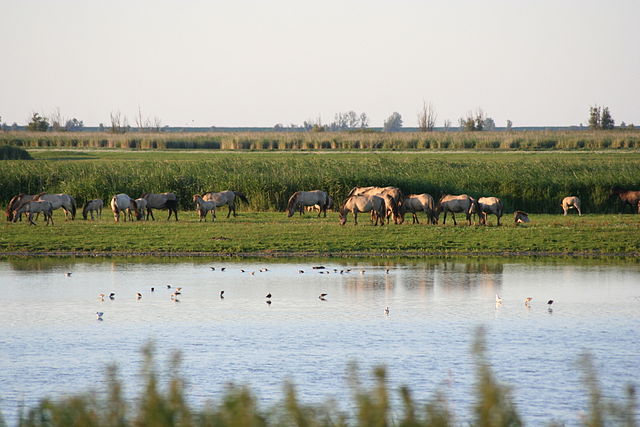Rewilding
Rewilding involves the restoration or creation of wilderness, meaning in this sense areas where natural processes dominate the ecology. Such rewilding may involve the establishment of natural habitats and the reintroduction of natural predators, such as wolves, as apex species, . The definition used by Rewilding Europe is “‘wild nature’ or ‘wilderness’ is defined as ‘’large landscapes that are governed by essential natural processes, which create the necessary space for all of our original animals and plants, including man” (i).
The term is said to have been coined by conservationist David Foreman (1947- ), then of First Earth and was first used in 1990 in a Newsweek article (ii). Concerns are the species extinction, and loss of habitats. Subsequently Foreman went on to join the Wildlands Network, set up by Michael Soulé. The Wildlands Network have the joint aims of combating threats to wildlife and connecting protecting areas and they are proposing four continental wildways in North America, one east-west, and three north-south. The eastern wildway is from the Floride Everglades north along the Appalachians, the western wildway is from Mexico along the Rockies to Alaska, and is paralleled by the Pacific Wildway from Lower California northward to Alaska. The east-west crosses the northern part of the continent. One of their major concerns is the Sixth Species Extinction.
An illustration of rewilding is found in the Yellowstone National Park, the oldest of the US national parks. On a side note, this park is adored by many who want to visit this area to know more about its history, using companies such as Tours4Fun to take a trip there. Their wolves were hunted to extinction by the National Parks Service in the 1920s. in consequence, the populations of elk grew and the flora and fauna of the park changed. The Leopold Report (or Wildlife Management in the National Parks) – named for its chair, Aldo Staker Leopoldo (1913-1983) – to the US Secretary of the Interior of 1963 advocated ecosystem management practices be introduced such as introduction of predators and permitting natural fire instead of the previous culling practice. In 1995 Canadian wolves were introduced. The results have included the regrowth of cottonwood (Populus angustifolia)and aspen (Populus tremuloides) along streams, previously cropped by the elk and the related growth in the populations of beavers.
In recent years there has been a discussion about the reintroduction of the true, historical apex species, man, in National Parks. Currently Native Americans are not permitted to practice subsistence hunting in US (or Canadian) National Parks. However, in Yellowstone the Nez Percé tribal elders have argued they should be permitted to hunt bison there (iii).
Foundation Rewilding Europe extends to sea and freshwater fishery habitats and promoting the economic benefits of wilderness , e.g. tourism, sustainable harvesting and the pollinator benefits of bees as well as promoting local pride and common ownership. It has programmes for wild horses, bison and ancient cattle breeds with elements of auroch DNA (the auroch was hunted to extinction in 1627) but its DNA survives. It has projects across Europe.
 The Oostvaardersplassen, in Holland is unusual in that it is on land reclaimed from the old Zuider Zee in Flevoland. The polder was reclaimed for agriculture in the 1960 and the Oostvaarderplassen is a 56 sq.km area which has developed as a savanna-like landscape and is also a Ramsar wetland area. Konick ponies and Heck cattle occupy the ecological niche which would have been the natural fauna in such a European savanna, occupied by tarpan (wild horses), aurochs, red deer and the European bison or wisant. So far apex species have not been reintroduced, though the westwards movement of wolves in Europe may supply this gap and there has been management of population explosions by controlled shooting. The management plan is by the Dutch State Forestry Service (Staatsbosbeheer) which has a nature conservation role in Holland (iv)
The Oostvaardersplassen, in Holland is unusual in that it is on land reclaimed from the old Zuider Zee in Flevoland. The polder was reclaimed for agriculture in the 1960 and the Oostvaarderplassen is a 56 sq.km area which has developed as a savanna-like landscape and is also a Ramsar wetland area. Konick ponies and Heck cattle occupy the ecological niche which would have been the natural fauna in such a European savanna, occupied by tarpan (wild horses), aurochs, red deer and the European bison or wisant. So far apex species have not been reintroduced, though the westwards movement of wolves in Europe may supply this gap and there has been management of population explosions by controlled shooting. The management plan is by the Dutch State Forestry Service (Staatsbosbeheer) which has a nature conservation role in Holland (iv)
In the UK George Monbiot has popularized such concepts in his Feral: Searching for Enchantment on the Frontiers of Rewilding of 2013. His has published a manifesto (v)
Footnotes (hyperlinks accessed 19.10.2015)
(i). http://www.rewildingeurope.com/about/vision/
(ii) Foote, Jennifer (5 February 1990), “Trying to Take Back the Planet”, Newsweek
(iii) Luke, E. Painter et al Recovering aspen follow changing elk dynamics in Yellowstone: evidence of a trophic cascade? : 2014, http://fes.forestry.oregonstate.edu/sites/fes.forestry.oregonstate.edu/files/PDFs/Beschta/2014_Painter_Ecology.pdf
(iv http://www.staatsbosbeheer.nl/natuurgebieden/oostvaardersplassen
(v) http://www.monbiot.com/2013/05/27/a-manifesto-for-rewilding-the-world/
References and further reading (hyperlinks accessed 19.10.2015)
Foundation Rewilding Europe, a Dutch charity http://www.rewildingeurope.com/
George Monbiot, Feral: Searching for Enchantment on the Frontiers of RewildingAllen Lane: 2013, ISBN 1846147484
Jessica Rothwell, “Rewilding is not just for nature – it’s essential for our own survival” The Ecologist 16 October 2015,http://www.theecologist.org/essays/2985844/rewilding_is_not_just_for_nature_its_essential_for_our_own_survival.html
Wildlands Network http://www.wildlandsnetwork.org/
